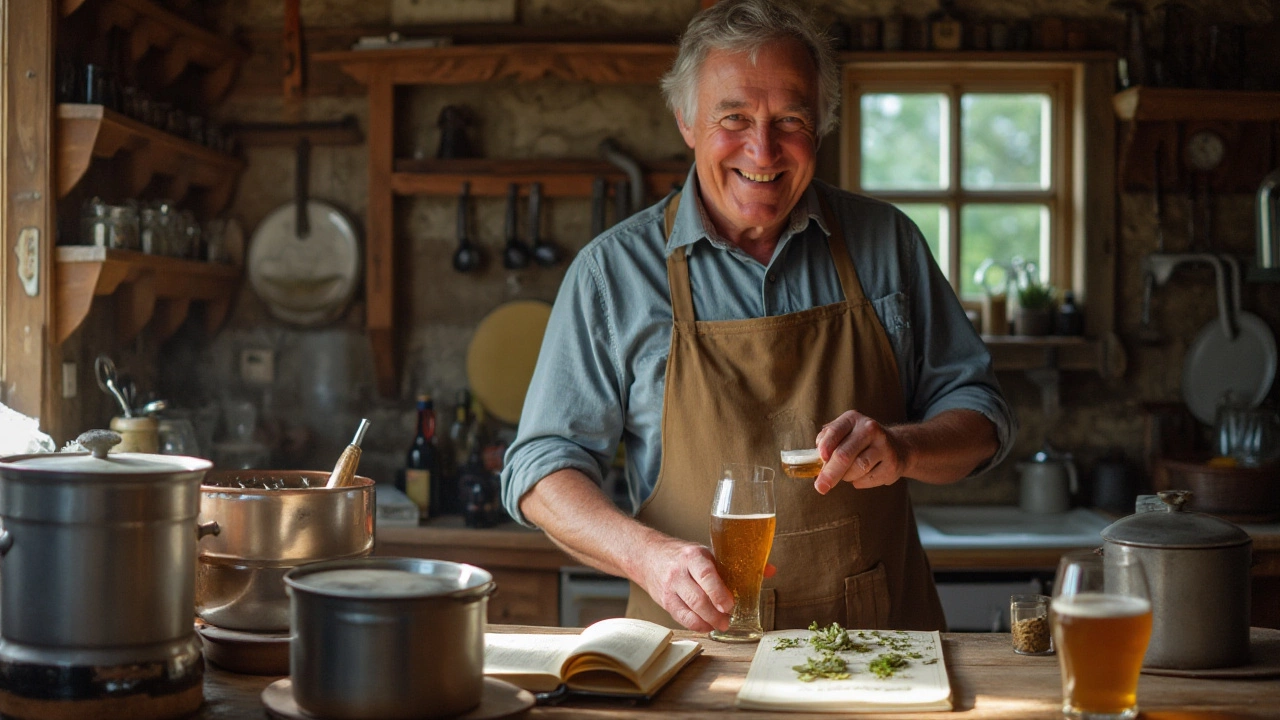Ever thought about crafting your own beer at home and delighting in the fruits of your labor? As mysterious as it might seem at first, home brewing is an art that can be mastered with the right guidance and set of tools. While the myriad of equipment available can seem overwhelming, knowing what you truly need helps simplify the process significantly.
Budding brewers need a handful of essentials to kick off their brewing adventure. A brewing kit usually contains a fermenter, airlock, and a hydrometer, each with a specific function ensuring your brew ferments perfectly. This article will walk you through what each piece does and why you can’t do without them when starting out.
But brewing isn’t just about the tools; it’s about understanding the crucial ingredients that come together in the alchemy of beer creation. Knowing what malt, hops, yeast, and water bring to the table will empower you to experiment and tweak your recipes as you gain confidence. Dive into this exploration and join a community of beer enthusiasts who believe that every bottle shared with friends is a testament to one’s creativity and patience.
- Setting the Stage with Basic Equipment
- Understanding Ingredients and Their Roles
- The Brewing Process Demystified
- Tips and Tricks from Passionate Brewers
- Common Challenges and How to Overcome Them
Setting the Stage with Basic Equipment
Embarking on the craft of home brewing begins by setting up the right environment with fundamental equipment, which acts as the backbone of the beer-making operation. Each component of the kit has a distinct role in the transformation of raw ingredients into that golden, frothy beverage we love. A standard home brewing kit comes equipped with a fermenter, often considered the workhorse of brewing, serving as the home where magic happens and yeast gets busy transforming sugars into alcohol. Fermenters can vary in size and material, commonly made from food-grade plastic or glass, each with its benefits and quirks. As a beginner, either option suits—what truly matters is the cleanliness maintained within this vessel to avoid unwanted bacteria that could spoil the brew.
Alongside the fermenter sits the airlock. This seemingly simple device plays a critical role in allowing carbon dioxide to escape the fermenter while keeping oxygen and potential contaminants at bay. Picture it as a safety gate that ensures your brew bubbles and ferments without interference. In the world of homemade beer, patience is a virtue, and the airlock ensures that your brew matures appropriately while you eagerly await the first sip.
Not to overlook, the hydrometer stands as a brewer's trusty instrument, measuring the specific gravity of the liquid and enabling you to evaluate how much sugar has been fermented into alcohol. This tool gives you insights into the strength and sweetness of your beer, guiding you in adjusting the recipe to fit your taste. It's not the flashiest component, but skilled brewers will tell you it’s indispensable for consistency and craftsmanship in your beer making journey.
"Beer is living proof that God loves us and wants us to be happy." - Often attributed to Benjamin Franklin, these words encapsulate the joy that crafting and tasting one's brew can deliver.
For those venturing into home brewing, ensuring you have the basic yet pivotal gadgets is a step in the right direction. It's more than simply collecting gear; it involves understanding each tool's purpose, enabling you to gain mastery over time. Drawing from centuries of brewing tradition, today’s equipment is honed and designed for ease of use, making brewing kits accessible to anyone. From seasoned enthusiasts to first-time brewers curiously diving into this hobby, setting up your stage with these fundamental items equips you to embrace the journey of turning barley and hops into a delicious drink right in your kitchen.
Understanding Ingredients and Their Roles
The artistry of crafting your own brew lies greatly in understanding the distinct roles each ingredient plays in the brewing process. When it comes to creating homemade beer, four primary ingredients serve as the foundation: malted barley, hops, yeast, and water. Each of these components contributes unique characteristics to the beer, influencing its flavor, aroma, and body, ultimately shaping the identity of your brew. It's an intriguing journey to watch how these components transform, from a humble barley grain to a refreshing and flavorful glass of beer. Let’s delve deeper into the essential attributes each brings to your brewing experience.
Malted Barley
Malted barley is often referred to as the soul of beer. This ingredient is the source of fermentable sugars, which the yeast will later consume and turn into alcohol and carbon dioxide. The process begins with the barley being soaked in water, allowed to germinate, and then dried with hot air, a transformation known as malting. The result is a roasted grain that contributes not only sugars but also a malty sweetness that is somewhat reminiscent of bread or cereal. The color and flavor of the beer are heavily influenced by the malt used. Lighter malts produce pale beers, while darker roasts result in those deep, rich tones seen in porters and stouts.
The Importance of Hops
Hops play several crucial roles in beer making. These cone-shaped flowers of the hop plant add bitterness, which balances the sweetness of the malt, and impart aromas that can be floral, citrus, or spicy, depending on the type used. Beyond these sensory additions, hops also act as a natural preservative, extending the longevity of your home brewing creations. “I often say, it's as if hops are the pepper in your dish, for without them, your meal—your beer—might just fall flat,” explains renowned brew master Jeremy Gilbert, encapsulating the essential function hops serve.
Unleashing the Power of Yeast
Yeast is the unsung hero of beer. This microorganism is the agent of fermentation, responsible for converting sugars into alcohol and contributing significantly to the flavor profile. Different strains of yeast offer different results: ales generally come from top-fermenting yeast, producing fruitier and spicier aromas, while lagers, fermented at cooler temperatures with bottom-fermenting yeast, are generally cleaner and crisper. Selecting the right type of yeast is crucial, as it not only affects the taste but also determines the efficiency of the fermentation process.
The Role of Water
Water isn’t just about H2O. The mineral content of your water changes the way it interacts with the other ingredients and the final taste of your beer. In fact, water makes up about 90-95% of a beer's composition, so its quality directly influences your brew's outcome. Brewers need to consider factors such as pH level and the amount of minerals like calcium and magnesium present. Adjusting these can make a significant difference between a good brew and an exceptional one. Remember, the water you choose forms the backbone upon which all other flavors are built.
“Beer is proof that God loves us and wants us to be happy.” – Benjamin Franklin. While the origin of this quote is debated, it emphasizes the joy and celebration often shared through beer brewing and consumption.
Balancing Act: The Symphony of Ingredients
Creating a delicious batch of beer is a delicate balancing act. You need to hone down on this craft to let each ingredient shine in harmonious unison. The ratio in which these ingredients are combined will significantly impact the beer's style, characteristics, and quality. Home brewers often start with pre-packaged kits that provide these ingredients in measured amounts, making it easier for beginners to focus on the process without being overwhelmed by the complexity of ingredient selection. But as you grow more confident, experimenting with adjustments and substitutions can become an art form in itself.

The Brewing Process Demystified
Embarking on your first brewing adventure can feel like attempting to decipher a cryptic language. Yet, the brewing process is essentially a series of steps that transform raw ingredients into the delicious craft that is beer. At its core, it's a symphony of science and art that begins with the careful selection of ingredients. The initial stage is called mashing, where malted grains are mixed with hot water to extract sugars. This forms the mash, and it is crucial to maintain the right temperature for optimal sugar extraction, which directly impacts the homemade beer's flavor and alcohol content. An important known fact is that the process of mashing generally occurs between 148 to 158 degrees Fahrenheit, a sweet spot that encourages enzymes to break down starches into fermentable sugars.
Once the mashing step is completed, the mash is separated into liquid wort and spent grains in a process called sparging. This stage allows you to filter out the wort, the sugary liquid that is the backbone of beer making. The next significant phase is boiling, where the wort is heated and hops are added. Hops introduce bitterness, aroma, and flavors that balance the sweetness derived from the malts. According to experienced brewers, the duration and timing of hop addition play pivotal roles in defining the character of your brew. Consider the words of master brewer Jon Hull, who once said,
"The art of brewing is knowing when to add your hops in a way that draws out the optimum flavor profile of your beer."
After boiling, it's time to cool the wort rapidly and transfer it to a fermenter. Fermentation is where the real magic happens, with yeast being the star player. Yeast consumes the sugars in the wort, producing alcohol and carbon dioxide. The fermentation process, depending on the type of beer, can last from a week to a month or more. Maintaining a consistent temperature during this time is vital, as fluctuations can result in off-flavors or even prevent your home brewing session from succeeding. It's fascinating to learn that different strains of yeast can greatly influence the final taste, making it a real game-changer in the brewing world.
Packaging is the final act of this dynamic production, where your beer finds its home in bottles or kegs. This is when additional carbonation is introduced, either naturally through priming sugar or via forced carbonation if using kegs. Home brewers often find bottling labor-intensive yet immensely rewarding, as it represents the culmination of weeks of dedicated effort. Proper sanitation and sealing are imperative to ensure the longevity and taste integrity of your homemade beer. Many enthusiastic brewers document that the first sip of their own bottled brew is an unforgettable milestone. The mixture of patience, anticipation, and creativity culminates here, offering not just a drink, but a personalized experience to share with family and friends.
Tips and Tricks from Passionate Brewers
Diving into the art of home brewing, many enthusiasts quickly learn it’s as much about creativity as it is about following a process. Experienced brewers often relay some pearls of wisdom that can make your brewing journey smoother and more enjoyable. A critical element to keep in mind is sanitation. Cleanliness can’t be overstated when it comes to brewing. Even the smallest contaminants can spoil an entire batch. Ensure all your equipment is scrubbed clean and properly sanitized before and after each use. A sparkling brewing environment promises a fresh and uncontaminated beer at the end of the cycle.
Another insightful tip revolves around being patient with your beer. It might seem tempting to crack open that bottle as soon as it looks ready, but remember, good things take time. Letting your beer ferment for a bit longer often yields better flavors. Keep a detailed journal of each batch you brew. Document the recipe, the process, the waiting time, and the final taste. This will serve as a reference for future brews, helping you replicate successful batches and rectify any mishaps.
Experiment and Learn
Embrace the spirit of experimentation. Home brewing allows you to try different ingredients and techniques to create something unique and personal. Many brewers choose to play with malt and hops to achieve varied aromas and flavors that you might not find in commercial beers. But while experimenting, ensure that you make incremental changes. Alter one element at a time, allowing you to discern what exactly contributed to the change in taste.
“The beauty of being a home brewer is the liberty to blend traditional recipes with your own creations. Each batch is an adventure.”
Community Support
Joining a local home brewing club or an online community can be immensely rewarding. Engaging with fellow brewers opens doors to a wealth of knowledge. Experienced brewers often share troubleshooting tips and advanced techniques. More significantly, this camaraderie introduces you to diverse perspectives and continuously ignites your passion. Don’t shy away from sharing your success stories or even your failures. Each conversation can spark new brewing ideas or recipes.
Leveraging technology can also be of great aid. Various apps are designed specifically for brewing, offering convenient ways to plan out recipes, keep track of brewing activities, and much more. These applications may even present calculators for precise measurements and timelines, lessening the chance of disparity in your brewing endeavors.

Common Challenges and How to Overcome Them
Diving into the world of home brewing isn't just a delightful adventure; it’s also a complex craft that presents its fair share of challenges. As a new brewer, understanding these potential hurdles and how to navigate them can make the difference between a successful batch and one that ends up being a learning experience. Starting out, one of the most frequent challenges is maintaining a consistent fermentation temperature. Fermentation is a delicate process, where yeast works its magic to transform sugars into alcohol and carbon dioxide. Too high or too low a temperature can stress the yeast, resulting in off-flavors or incomplete fermentation. Investing in a temperature control system or using a simple swamp cooler can provide a more stable environment for your brew.
Another common issue is contamination. A seemingly innocent mistake in cleanliness can ruin an entire batch. Everything that comes in contact with your brew after the boiling stage needs to be sanitized. This might sound daunting, but adopting thorough cleaning processes and using quality sanitizing solutions can help avoid unwelcome bacteria or wild yeast from taking hold. Even experienced brewers double or triple check their cleaning procedures to ensure perfection. Remember, bacteria are not visible to the eye, so trust your methods.
Moving forward, balancing ingredients can puzzle many beginners. The ratio of malt to hops influences the sweetness, bitterness, and aroma of your beer. Each ingredient has its own potent characteristics, and dialing in on the perfect balance is part of the learning curve. It's often advised to start with tried-and-true recipes, making notes and adjustments with each brew. Learn to appreciate the subtle nuances of each ingredient; soon you will discern how to adjust recipes according to your personal taste.
In the words of celebrated brew master John Palmer, "Brewing is both an art and a science. Enjoy the process, and don’t be afraid to make mistakes — they will be your best teachers."
Packaging can also present a challenge, especially for those ambitious enough to skip bottling and go straight to kegging. Whether you're bottling or kegging, ensuring your brew is carbonated just right is crucial. An undercarbonated beer lacks life, while one that's overcarbonated can gush out unpredictably. Learning the correct measurements of priming sugar and time for carbonating can take a few runs but adds a satisfying sparkle to your final product.
Lastly, patience is often the unseen challenge in the brewing process. It's tempting to crack open a bottle as soon as it looks ready, but beer needs time to reach its full potential. Most brews benefit from some aging – allowing flavors to meld and mature. Embrace the waiting time by planning your next brew or by learning more about the intricate world of brewing. After all, the time spent apart will make the joy of sipping your homemade beer all the more rewarding.


